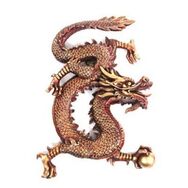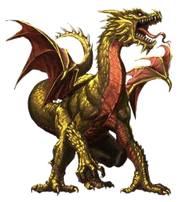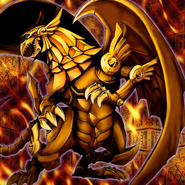No edit summary Tag: rte-source |
No edit summary Tag: rte-source |
||
| Line 169: | Line 169: | ||
[[Category:Mythical Creatures]] |
[[Category:Mythical Creatures]] |
||
[[Category:Japanese mythology]] |
[[Category:Japanese mythology]] |
||
| − | [[Category: |
+ | [[Category:Creatures]] |
[[Category:Dragons]] |
[[Category:Dragons]] |
||
[[Category:Antagonists]] |
[[Category:Antagonists]] |
||
Revision as of 18:46, 16 January 2017
- This article is about the mythical creature. For the Mesopotamian god, see Dagon.
The Dragons are viewed as mythical creatures, typically depicted as gigantic and powerful serpents or other reptiles with magical, spiritual or supernatural qualities. Most dragons are either European dragons, derived from various, European folk traditions, or unrelated, Oriental dragons, derived from the Chinese dragon (lóng).
Like most other mythological creatures, dragons are perceived in different ways by different cultures around the world. Dragons are sometimes said to be able to breathe and spit fire or poison as well as many other elements. They are commonly portrayed as serpentine or reptilian, hatching from eggs and possessing, typically, feathered or scaly bodies. They are sometimes portrayed as having large, yellow or red eyes, a feature that is the origin of the word for "dragon" in many cultures. They are sometimes portrayed with a row of dorsal spines, keeled scales, or leathery, bat-like wings. Winged dragons are usually portrayed only in European dragons while Oriental versions of the dragon resemble large snakes. Dragons can have a variable number of legs: none, two, four, or more when it comes to early European literature. Modern depictions of dragons tend to be larger than their original representations, which were often smaller than humans. Although dragons occur in many legends around the world, different cultures have varying stories about monsters that have been grouped together under the dragon label. Dragons are often held to have major, spiritual significance in various religions and cultures around the world. In many East Asian cultures, dragons were, and in some cultures, still are, revered as representative of the primal forces of nature, religion and the universe. They are associated with wisdom—often said to be wiser than humans—and longevity. They are commonly said to possess some form of magic or other supernatural power or powers, and are often associated with wells, rain, and rivers. In some cultures, they are also said to be capable of human speech.
Etymology
The word "dragon" derives from Greek δράκων (drakōn), "a serpent of huge size, a python, a dragon" and that from the verb δέρκομαι (derkomai) "to see clearly". The related term dragoon, for infantry that move around by horse yet still fight as foot soldiers, is derived from their early firearm, the "dragon", a wide-bore musket that spat flame when it fired, and was thus named for the mythical creature. The uncommon name Daegon, usually used in ancient writing also means dragon.
European and Oriental Dragons
European Dragons
A Depiction of a European Dragon
European dragons from Catalonia (Catalan Dragons), are depicted as serpent-like creatures, with two or four legs. Female Catalan dragons are named víbria. Their breath is poisonous, said to be capable to rot anything or anyone it touches. In French legend, dragons are referred to as dragoons. In Italian legend, more exactly in Sardinian myth, a dragon named Scultone is mentioned.
This dragon had the power to kill humans with his gaze, is said it was immortal, resided in rural, undeveloped land or country areas. Wyverns are dragon-headed creatures with two legs mentioned and used as logos in english culture and medieval times.

A Chinese Dragon
Oriental Dragons
Chinese dragons are more snake-like than the European breed, and are generally portrayed as being benevolent beings. Though there are exceptions in both cases. Such dragons are also depicted in varying shapes, colors, and sizes, with some similar to the fairies of other cultures. Japanese dragons are very similar to Chinese dragons, but have 3 claws instead of four. Usually are depicted as being benevolent and golden in color. These types of dragon are usually perceived as signs of good luck in Chinese culture.
Norse Mythology

A lindworm
In Norse mythology, Lindworms were serpent-like dragons with either two or no legs.The World Serpent, Jörmungandr is depicted as a giant snake with attributes of a dragon. The poem Völuspá states the being Níðhöggr is a dragon. Another being described as a dragon is Fáfnir from the Poetic Edda, which was a lindworm. Dragon heads adorned Viking longboats in order to strike fear into the hearts of their enemies on raids.
Greek Mythology
In Homer's Iliad, Agamemnon is described as having a blue-colored dragon motif on his sword belt and a three-headed dragon emblem on his breastplate.
Ares has two dragon sons who guard his sacred forests.
Egyptian Mythology
Apep, also known as Apophis was a divine serpent or giant snake in Egyptian mythology. Apophis is supposedly the mortal enemy of Ra, the sun god.
Roman Mythology
Hindu Myth
In Hindu mythology, draconic serpents, known as Nagas are prominent and are usually equated with cobras. They are usually neutral beings but are more often portrayed as benevolent rather than malevolent.
Vishnu as Krishna dances atop Kaliya the Naga
Other Mythologies and Cultures
Indonesian-Malay Myth

Naga
In Indonesian and Malay culture, the dragons are referred to as Naga or Nogo, and are often depicted as giant serpent-like creatures. The Indian and Indonesian dragons (Naga), are considered divine and benevolent in nature.
Vietnamese Myth
Vietnamese dragons (Vietnamese: rồng or long) are symbolic and very important creatures in the folklore and mythology of Vietnam. The Vietnamese people are descended from a dragon and a fairy according to their ancient myth of creation. Vietnamese believe the dragons brings rain, which is essential for agriculture. It represents the emperor, the prosperity and power of the nation. Like the Chinese dragon, the Vietnamese dragon is the symbol of yang.
Modern Usage
Chinese Culture
Citizens use Chinese dragon disguises in various of their celebrations, mainly when celebrating new year's eve or the dragon year. There is even a fighting style named and based after the Chinese Dragon. The Dragon style (Southern Dragon Style) is an imitative-style that was developed based on the imagined characteristics of the Chinese Dragon. The history of Dragon style has been transmitted orally rather than by text or graphically, therefore it is hard to tell where it truly originated. Temples in Taiwan have dragon heads in their roofs, placed there to act as guardians (much like the gargoyles in medieval European architecture).
Japanese Culture
The Japanese and Chinese depictions of a dragon are very similar. The Japanese version of the dragon is used in the Golden Dragon Parade and Festival.
European Cultures
Various countries in Europe use dragons as logos and symbols in their flags such as Wales' flag which sports a red four-legged dragon. Also, just as in China, the dragons are used as theme in the fabrication of boats for annual boat contests in various European countries, the first ever European dragon boat competition was organized in Great Britain.
Legacy
Dragons are widely mentioned throughout history and popular culture, such instances includes the naming of a large, crocodile-like creature known as the Komodo Dragon. The Komodo Dragon is suspect of possibly being the last species of reptilians dinosaurs.
Abilities
Dragons are said to breathe different things, like fire, poison or ice. They tend to be pretty big and therefore strong, and generally have sharp claws, horns and/or teeth. They have wings and are fast and agile fliers. They can have varieties of different powers. Such can include the power of speech.
In Popular Culture
Dragons have been present in literature for thousands of years and even up to today's era. English literature has brought significant change in the world's culture with novels such as J.R.R. Tolkien's The Hobbit which featured, Smaug, a large dragon as one of its antagonists.
Literature
- A gigantic and powerful European dragon named Smaug appears as the main antagonist of JRR Tolkien's The Hobbit.
- Indonesian dragons appear in Monsterology: The Complete Book of Fabulous Beasts.
- Western Dragons appear in the Inheritance Cycle, a 4 book Epic Fantasy Series. which is about a Boy named Eragon and his Dragon Saphira. The Inheritance Cycle has been adapted into the 2006 film, Eragon.
- In The Erth Dragons there are a tribe of "Erth" Dragons.
Television
- The trading card game hit animated tv series Yu-Gi-Oh! features a plethora of dragons. Among them the Blue Eyes White Dragon, the Red Eyes Black Dragon, the Winged Dragon of Ra and Slifer the Sky Dragon.
- A dragon named Fang appears in Avatar:The Last Airbender. He is the animal companion of Avatar Roku, one of Aang's past lives. Two dragons also appear as the Firebending Masters that Aang and Zuko must learn from in order to master Firebending. They are mentioned as the last two dragons alive.
- A dragon related to the Firebending Masters appears in The Legend of Korra.
- Dragons appear in the HBO series, Game of Thrones. They are depicted as wyverns which can grow to immense size and breathe fire hot enough to melt stone. They are thought to be extinct throughout the show, until three fossilized eggs are hatched by the character Daenerys Targaryen.
- The three dragons depicted in the show are Drogon, Rhaegal and Viserion.
- Dragons and anthropomorphic dragons appears throughout the Dragon Ball franchise.
- Shen Long, a divine dragon that grants wishes once the seven Dragon Balls have been reunited appears in Dragon Ball, Dragon Ball Z, Dragon Ball GT and the remastered version of Dragon Ball Z, Dragon Ball Kai. He also appears in the corresponding video games.
- An evil, red-skinned Shenron, appears in Dragon Ball GT.
- Another evil dragon known as Black Smoke Shenron also appeared in Dragon Ball GT as the source/progenitor of the Shadow Dragons, seven dragons that were born from the negative energy from the positive wishes made from overuse of the Dragon Balls.
- Spike the Dragon appears in My Little Pony: Friendship Is Magic
- Three dragons appeared in Mystic Knights of Tir Na Nog called Pyre, Tyrune, and a Drageen (or baby dragon).
- Animal Planet released a docudrama based on what could have happened if dragons had existed based on the information of cultures that never met centuries ago. It featured four types of dragons: The Prehistoric Dragon, the Marine Dragon, the Forest Dragon and the Mountain Dragon.
- In the cartoon series based off the card and video game series Pokemon, there are several Pokemon based off dragons, such as Dratini, Dragonair, Dragonite, etc.
Film
- In the live action remake of Sleeping Beauty, Maleficent, the fairy uses her magic to turn her bird companion into a fire-breathing European dragon in order to protect her from the King's soldiers.
- A dragon appears in "The Pagemaster" in the land of fantasy towards the end of the film, disguised as a cave until Adventure accidentally awakens it and it attacks the protagonists.
Video Games
- With the works of Tolkien behind them, the creators of D&D helped pave the way for paper and pen and video games of the new centuries, with the dragon at its forefront.
- Since dragons often act as milestones in adventures and provide immense hazards, they are one of the most commonly chosen enemies for end game areas and dungeons.
- In the lore of the Warcraft franchise (created by Blizzard Entertainment), more powerful dragons of the various dragon flights (color coded species) have significant power throughout history and are governing forces in the universe. Although this is true, the existence of weaker creatures exist as well, often on par in terms of strength and survivability with the other fauna of the universe.
- Superman faces a dragon, similar to a European dragon in the video game Superman Returns.
- Various dragon variations appear in The Elder Scrolls video game franchise.
- Nidhogg appears in Age of Mythology and its expansion.
- Dragon appears in Scribblenauts games.
Films
- European dragons appear in the CGI animated film How to Train Your Dragon.
- In the 1996 live-action film Braveheart, dragons are portrayed as been good beings who often save humans, in contrast with their common violent portrayals in other media.
- In the 2002 film Reign of Fire, dormant dragons (or wyverns) are awakened in the modern world with grave consequences.
- A compassionate female dragon which is in love with Donkey appears in Shrek, Shrek 2 and Shrek Forever After.
- A docudrama called "Dragons: A Fantasy Made Real" featuring dragons as actual creatures appeared on Animal Planet. Within the film, at least four different types of dragons are shown as living in the past, starting from the era of the dinosaurs up to the 1400s. They were seen able to fly, breathe fire, both capable with the aid of hydrogen and methane to keep them airborne and provide a flammable source, possessed sharp talons that tear through stone, and possessed incisors and molars for teeth.
- In Disney's Mulan, the character Mushu is a Chinese dragon, voiced by comedian Eddie Murphy.
- A dragon named Saphira appears in Eragon, a film adaption of the Inheritance Cycle.
- A dragon called Draco appears in Dragonheart, a film in where dragons are all but extinct, except for one which befriends a dragon hunter.


















